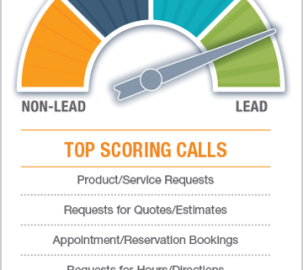How do you know whether a call is a good lead? Lead scoring can be tricky, but columnist CJ Arseneau explains why it’s essential that marketers gain insight into ad-driven phone calls.

You may already be measuring the success of your marketing programs by tracking offline phone leads and using the data as proof of ad performance. If so, you rock! But do you really know how many of those calls are viable leads?
Were the callers interested in more information? Were they calling to set up an appointment? Did they leave a voice mail? And which of these actions constitutes a lead?

Call scoring and the ability to easily evaluate the nature of an ad-driven phone call is priceless. After all, advertisers want the phone to ring — but for the right reasons.
Therefore, it’s critical to understand the most basic elements of the calls being driven by your ad programs, not to mention what happens when the consumer and advertiser connect and how to properly evaluate that dialogue against a set of lead quality criteria.
While lead scoring can be complicated, a few guidelines can help marketers quickly evaluate whether a call was a quality lead, resulting in a more accurate evaluation of their lead traffic.
Gaining Insight Into Good Vs. Bad Calls
Advertisers are looking to distinguish between “good” and “bad” calls. While the definition of a “good call” can be fairly subjective, it generally refers to a potential sales opportunity.
Call recordings help provide the necessary insights into good vs. bad calls.
To glean these insights, some conversation analysis solutions utilize speech analytics technology for keyword detection and discovery, while other companies manually score a subset of calls.
Either way, it is important to take time to consider lead criteria and category nuances to help identify a pre-set list of positive and negative keyword phrases and/or caller dispositions to appropriately score calls.
Let’s start with the good calls. Here are the Top 5 dispositions most closely aligned with a quality lead. These calls represent callers who are considering a purchase and could likely become customers.
- Product/service request – I’m in the market for new tires.
- Request for quote/estimate – I need my kitchen painted; can you please give me an estimate?
- Making an appointment/reservation – Do you have reservations for four people at 7 p.m.?
- Request for hours/directions – What time are you open on Sundays?
- General inquiry for more info – What is the process for writing a will?
Non-lead calls can generally be attributed to these Top 5 dispositions:
- Appointment cancellations
- Connection issues
- Personal calls/wrong number
- B2B inquiries/solicitation
- Product/service requested doesn’t match business’ offerings
Marketers who consider the top dispositions associated with good calls vs. non-lead calls are able to better identify opportunities and optimize their marketing programs.
Of course, there is always a gray area that will depend on the call scoring provider’s approach and how each advertiser handles inbound calls. For example, voice mail calls, depending on the nature of the message, could also very well be quality leads.
Additionally, inbound calls for products that don’t match the business’ offerings could be transformed into cross-selling opportunities, given the right approach. Consequently, these types of calls should be evaluated on a case-by-case basis.
On average, marketers should strive for at least 70-80 percent of ad-driven calls to qualify as leads. Category nuances can shift these target numbers one way or another, but this type of proof of ad performance is vital for accurate measurement.
Similar to evaluating other types of call response data, marketers should regularly review ongoing call scoring data and the breakdown by lead source. This analysis will help offer a clear picture of overall call-driven lead quality and can be used to optimize marketing programs to drive more high-scoring calls.
Ultimately, companies want to know that their ad investments are helping them grow their business, and they’re demanding more qualitative measurement of lead generation. Call scoring is becoming an essential piece of the lead measurement equation.
Some opinions expressed in this article may be those of a guest author and not necessarily Marketing Land. Staff authors are listed here.
(Some images used under license from Shutterstock.com.)
Marketing Land – Internet Marketing News, Strategies & Tips
(76)







